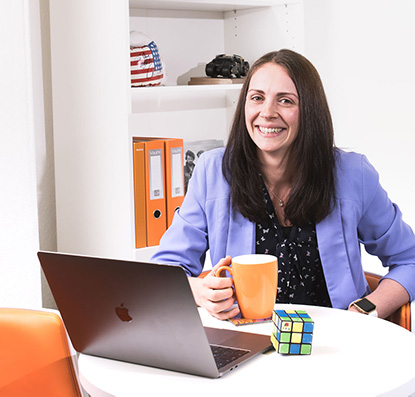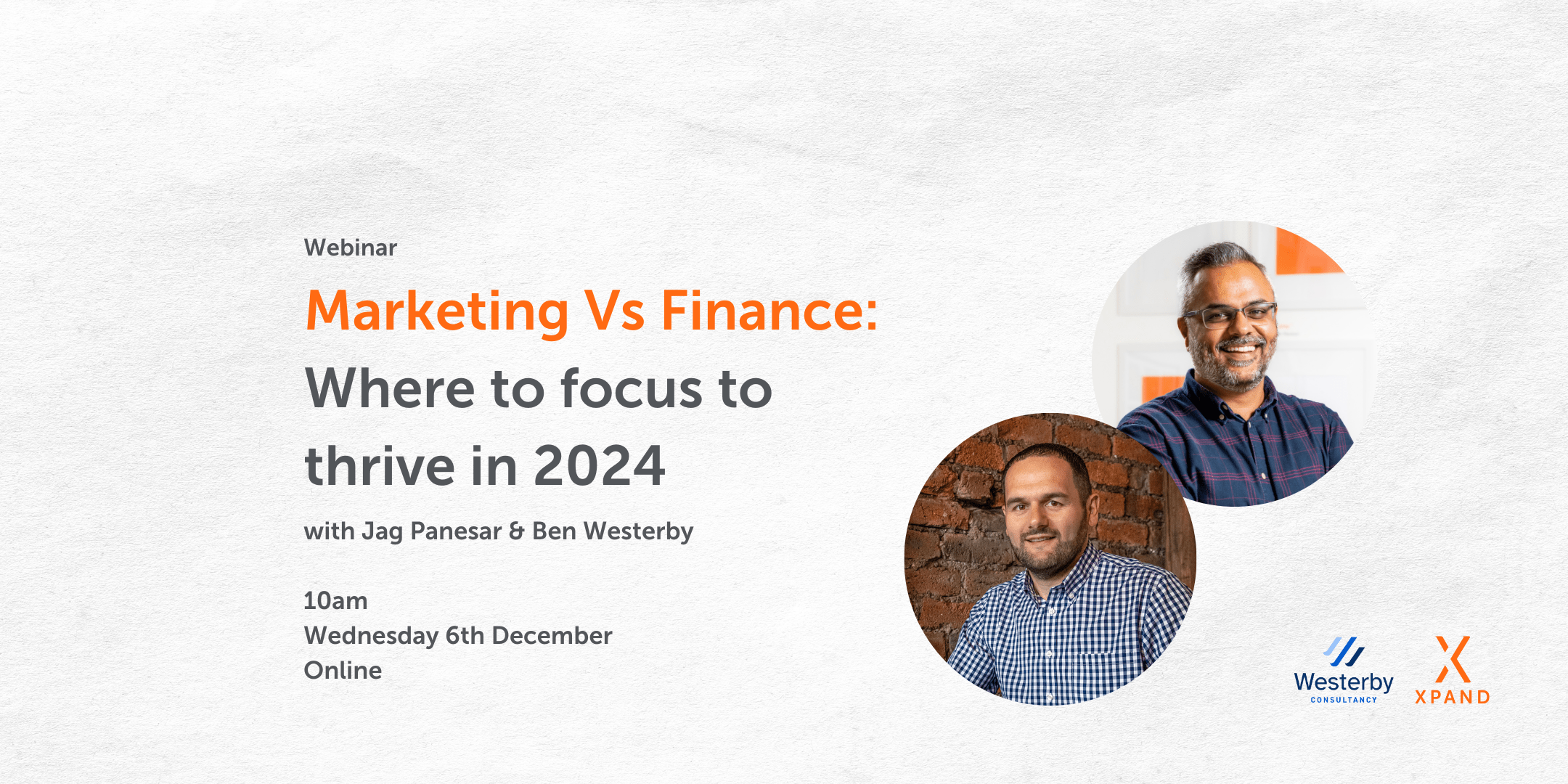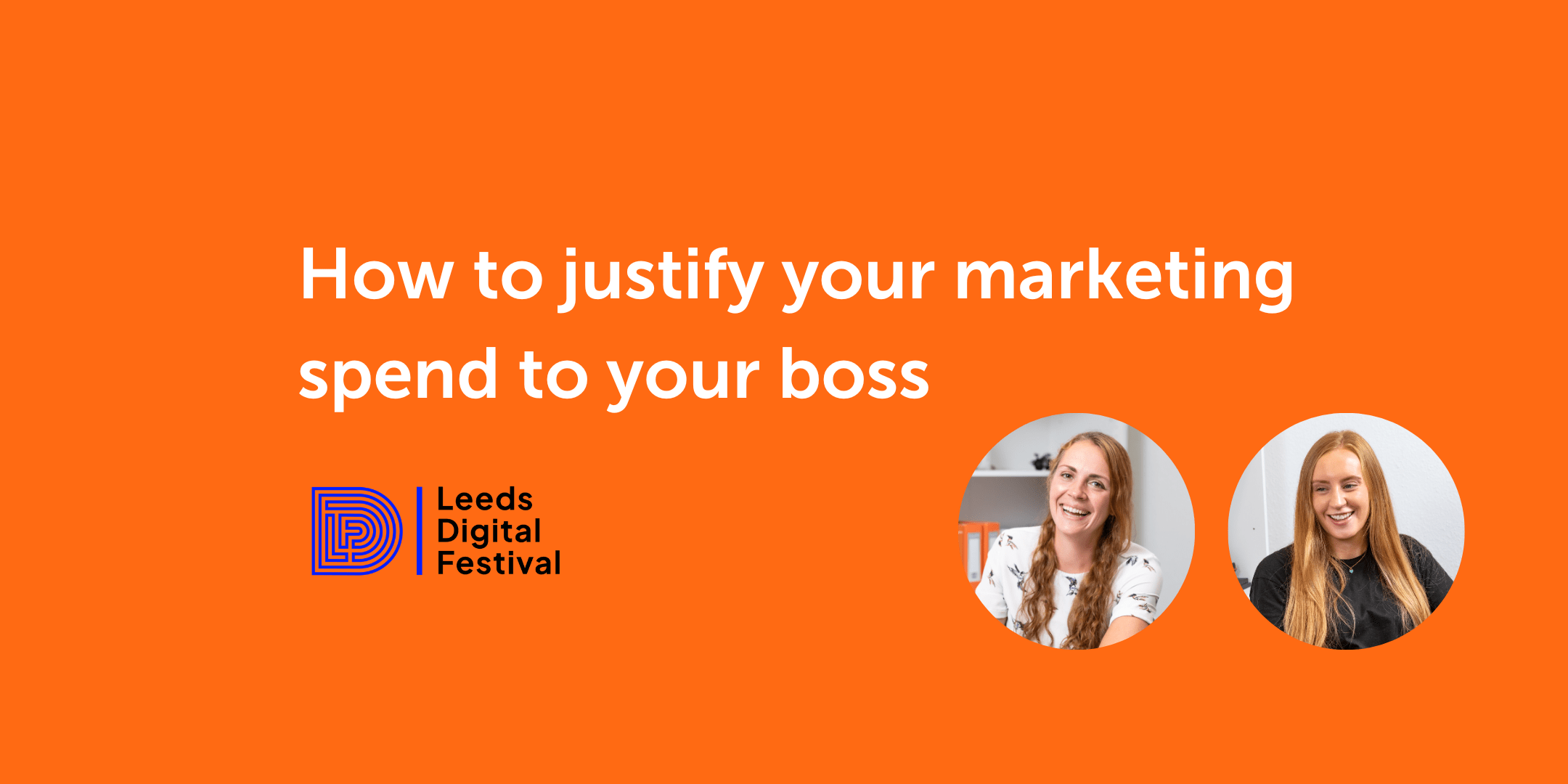Search marketing has dominated the digital world for some time now. However, for the first time in the digital world, social media is taking over search marketing.
Should you be placing more focus on social media rather than your website and SEO, and what does this mean for business platforms such as LinkedIn?
Consumer behaviour is constantly changing, which is having an impact on the buyer’s journey. People are now using social media to research a brand as well as other platforms such as company websites. This shift in behaviour means that if you’re not getting your social media right, you could be removing yourself from the running pretty quickly.
It’s also important to realise that the younger generation will ultimately become senior decision-makers somewhere down the line, so how are you connecting with them?
We recently delivered a free webinar as part of the Leeds Digital Festival to discuss how to decide where to place your marketing budgets.
In this webinar, we covered:
- How your audience are using social media and Google to find your business
- Future predictions for social media in the B to B arena
- Future predictions for websites and SEO in the B to B arena
- How to decide where to invest your budgets
- Useful tools
Slides
You may have seen a recent comment made by the Senior Vice President of Google, Prabhakar Raghavan stating:
“In our studies, something like almost 40% of young people, when they’re looking for a place for lunch, they don’t go to Google Maps or Search…they go to TikTok or Instagram.”
Prabhakar Raghavan – Senior Vice President of Google
This might have sparked panic, especially if you’re a B2B business. But it’s important to understand that Instagram and TikTok aren’t search engines and when it comes to B2B, most people still start off with traditional search engines.
Still not convinced? Here are some internet usage stats…
- There are 67 million internet users in the UK (Jan 2022). That’s a 4% increase year on year.
- 98% of the UK uses the internet
- 44% of global users visited a brand’s website each month
- 6hr 16m spent using the internet each day
- The most visited website online is Google
Data source: datareportal.com
Social Media isn’t replacing Google. But, it isn’t going away either.
Looking at the above stats, it may seem like Google and your website are where you should focus most of your marketing budget, but before you start jumping to conclusions, things aren’t that simple, here are some social media usage stats:
- 58 million social media users in the UK (Jan 2022). A 10% increase year on year.
- 85% of the UK are active social media users
- 1hr 53 mins spent using social each day
- 30% of the UK use social media for brand research
Data source: datareportal.com
In addition to the stats above, we’ve also seen some incredible advancements and news stories when it comes to social media. Recognise any of the below?
Wow, tough competition, right?
Let’s have a look at a few predictions for social media.
Future predictions for social media in the B2B arena
Last year we made some predictions for 2022, we predicted that:
- Value-adding content will take the lead
- Video will continue to take centre stage
- Social media channels could also become shopping channels
- Authenticity will be vital
- Personalisation will be key
And almost all, if not all of these predictions, have become reality. We’re now seeing so much more of the above in our social media feeds today.
So what does this mean, going forward?
Our predictions for the future
Going forward, we feel that the following predictions will take effect:
- The rise of influencers in B to B
- Brand inclusivity will be critical to brands, but employee advocacy will help too
- Gen Z will change the way brands view & use social media
- Brands will need to create conversational and interactive content
- Audio will really take off
However, the predictions you really need to take note of are:
A video marketing strategy will be key
Short form video is booming, the question is – are you taking advantage of this for your B2B business?
The brain processes images 60,000 times faster than text. We can only process 5 words per second, and our attention span is roughly 8 seconds long. In addition to this, video is a much more digestible medium. It allows you to connect on a deeper level with your audience.
If you’re still not convinced, consider this – with video you can achieve:
- 10x more engagement on Twitter
- 20x greater chance of shares on LinkedIn
- 8 billion views per day on Facebook
- 8x higher CTR (click-through rate) on your email campaigns
- 118% organic reach on Tik Tok
37% of the UK population watch how-to, tutorial or educational videos each week
Dataportal.com
According to CISCO, as much as 82% of online content will consist of videos this year. Source: Takenote
In addition to the stats above, 70% of Tik Tok users say they’ve discovered a new product/brand on the platform, even though it only ranks 6th in the world’s most-used social platforms, that’s still an impressive number.
If you thought TikTok is just for kids and not really a platform for your B2B business, then think again. There are a number of B2B brands doing it right and gaining huge traction. Below are some examples:
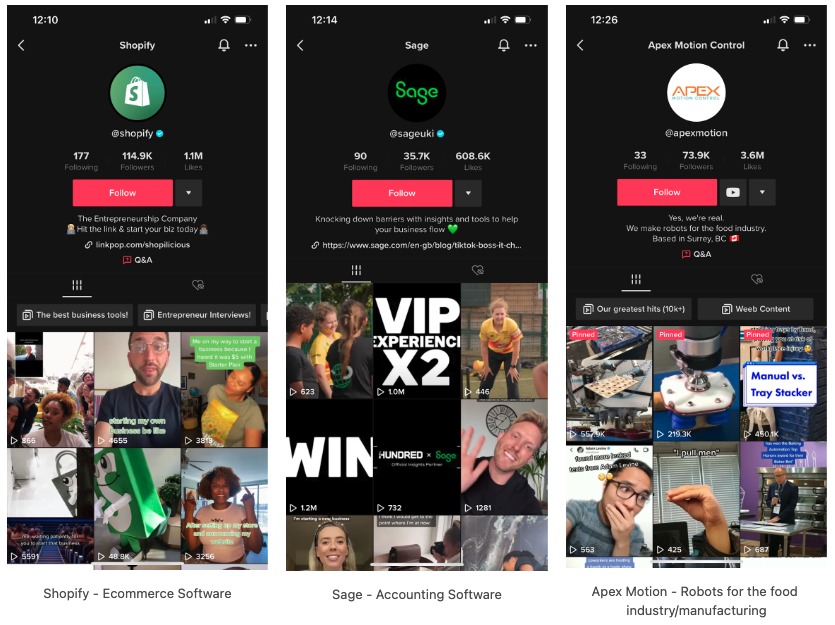
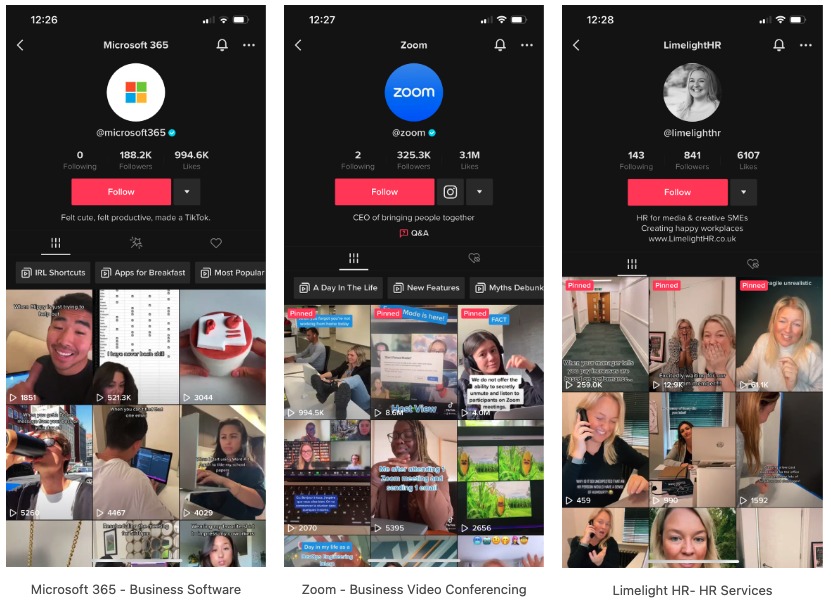
These brands have great follower numbers, but in the UK, 22 million people have TikTok, but 35 million have Facebook. So how do you decide where to invest your time?
This will be dictated by your target audience. Which platforms are they on? Are they on one platform or multiple platforms? You can get all this information and more when you create a detailed audience persona for your brand.
Social advertising in B2B will increase
Google is set to phase out third-party cookies. This means limited tracking capabilities forcing platforms to rethink their advertising capabilities.
Consumers appear to be more receptive to ads that are authentic, this includes user-generated content, unpolished raw content, testimonials as well as branded content.
So the barrier to entry has been reduced, as you can simply take your smartphone and create an ad on the spot.
The potential reach for ads is huge in the UK alone and it’s growing every day, below are some figures to give you an idea:
- 61.6% on Facebook
- 91.8% on YouTube
- 63.7% on LinkedIn
- 55% on Instagram
- 44.6% on Tik Tok
- 34.5% on Twitter
Social experience will accelerate
We’re finding that social media platforms are being used for much more than what they were originally designed to be used for, this includes:
Community management – People are using social media to complain, give reviews, or even contact companies for customer support queries. Most people expect a response within 3 hours to their query. There is a lot more that you can do with your social media than just putting out branded messages.
Crisis management – Curating a community on your social media platforms can allow you to better connect with your customer and manage crises or complaints quickly before they escalate. We’re all human, and humans like to complain. Social media is making this easier, so make sure you have an effective social media strategy in place to manage these crises.
Customer journey – The B2B customer journey is ever more complex than B2C, it’s not a linear journey, and things take a lot longer. In fact, research shows that at least 7 touch points are needed before a buying decision is made. The good news is that you can use social media effectively to make these touch points with your target audience and move them down the buyer’s journey.
This means that brands will need to take into account the wider experience associated with a social media presence and may even need to employ dedicated community managers to work alongside your social media teams.
Future predictions for websites and SEO in the B2B arena
We’ve spoken a lot about social media, but let’s move on to Website and SEO, and our predictions for those, which are:
- Businesses will gather more data to support their sales funnel
- CRM integrations will continue to gain prominence
- Third-party integrations will continue to grow e.g. Calendly
- Online reviews will support the truth of your brand
- Google Analytics 4 will give us even more user intelligence
However, the predictions you really need to take note of are:
Website User Experience (UX) will continue to gain prominence
When a website is poorly built, we notice it. We can’t find forms, we can’t find the things we’re looking for. If there’s too much text, or if there are too many images, it just feels wrong – and we go elsewhere.
However, when a website is easy to use, we don’t notice it. It’s a seamless process.
Technology is making website design easier. Platforms such as Wix, and Squarespace allow simple but effective websites to be created on a budget (though they do also have a lot of bad points), and they all have well-thought-out templates that provide a simple and effective user experience.
The templates provided by these websites can allow you to get up and running within a matter of days. Not only that, they’re making it easy to integrate great UX, right from the get-go.
Your website’s written content is fundamental to how your audience perceives you and remembers you. It’s not just about a pretty design, it’s about usability and ultimately about whether they got the information that they were looking for.
Brand authenticity and messaging on your website will become more central
Gone are the days that you can put anything on your website and it won’t get challenged.
With consumers becoming savvier, they are gravitating toward brands that are authentic and have clear messaging on their websites.
Some things to consider here are:
Access to social proof – This allows prospects to research your brand further using social channels and review websites. So if your website’s brand message isn’t authentic, it’ll quickly come out in the wash.
We have an attention span of 8 seconds – If your website’s branding and messaging aren’t getting to the point quickly, you’ll lose your user’s attention. Get to the point as quickly as you can.
Recruitment continues to be a challenge – Your brand and website aren’t only there for customers, it’s also a storefront to attract the best talent. People will use the company website to gauge if a company is worth working for. Make sure it communicates your core values and personality as a brand.
Cut through the noise – To cut through the noise you need to position yourself as an authority. High-quality website content will build trust, generate engagement and gain loyal followers.
High-quality content is key – Producing high-quality content is tricky, but it’s rewarding if you get it right. Search engines love it when your content is helpful, engaging and targets a specific audience. Strategic keyword usage can also help gain traffic from a more qualified audience that is likely to convert quicker.
Website content will become even more people focussed
Google recently released the Helpful Content Update. This means that the following types of websites will be rewarded when it comes to SEO:
- Sites that don’t stray too far from their main topic
- Sites that demonstrate first-hand experience
- Sites that provide sufficient answers to searchers’ questions e.g. FAQs
In short, Google is getting better at recognising when you’re trying to ‘play’ the system, our advice is just to be human.
Google Vs your brand
Here’s a question.
If you searched on Google for an accountant, but in the search results at position one, you saw a company that you didn’t recognise, yet at position two was a company you knew well, which one would you click on?
Most people we ask this question go for the company in position two, simply because they recognise the brand and so trust it more.
This shows that position one on Google will remain important, but your brand will dictate your website enquiry rate. Brand trust can dictate the strength of your enquiries and conversion rates.
There’s lots of noise on Google -paid ads, the map pack etc. Your brand will help you cut through this noise. Your brand needs to be present across as many audience-relevant channels as possible.
Other things to consider…
So, with such great arguments for social media AND websites, how do you decide where to invest your budgets? Well, it depends on a few other factors:
Your Target Audience
You need to consider your audience. An audience persona is an in-depth description of someone who reflects your target audience. It’s not a real customer, but a fictional person, representing the characteristics of your potential customers.
This means you need to consider the who, what, why, where, when and how – in relation to your prospects.
If you don’t currently have a target audience persona then we have a full webinar that outlines why they are important and how to create one here.
Example Persona
Current Enquiries
Look at where your current enquiries are coming from, where are the majority of your audience coming from? This is the starting point.
Are they on social media? If so, what can you do to gain even more enquiries from that channel?
Maybe they’re coming from your website? Again if so, how can you maximise your enquiries from that channel?
Word of Mouth
Word of mouth is by far the most powerful form of marketing. Which is dictated by your brand strength and can be harnessed through social proof.
Make sure you’re asking for Google reviews, and testimonials when you’ve done a good job!
Resources
Another thing to consider is what resources you have in-house to execute your social media or website strategy. We all have 24 hours in a day, so how can you allocate your time effectively to make sure the channel you have chosen is nurtured effectively?
In addition to time and resources, what you also need to take into account is the knowledge you have in-house. Do you have team members that have in-depth knowledge of the social media or website arena? Can they execute a social media or website strategy effectively and deliver the KPIs you are looking for?
Tools to improve your digital marketing strategy
Datareportal: They do regular reports to break down key metrics related to social media and social media platforms.
Publer: Social media scheduling tool to help you stay consistent with your social media content.
Google Analytics 4: This is Google’s data platform that shows you all the metrics in relation to your website. Here are the important changes you need to be aware of.
Rival IQ: This is a comparison tool. You can use it to do social media competitor analysis to see what your competitors are doing better than you and take that information to improve your own marketing.
Stats from webinar
Here are some results and stats from the 86 delegates that attended this event and answered an on-the-spot poll:
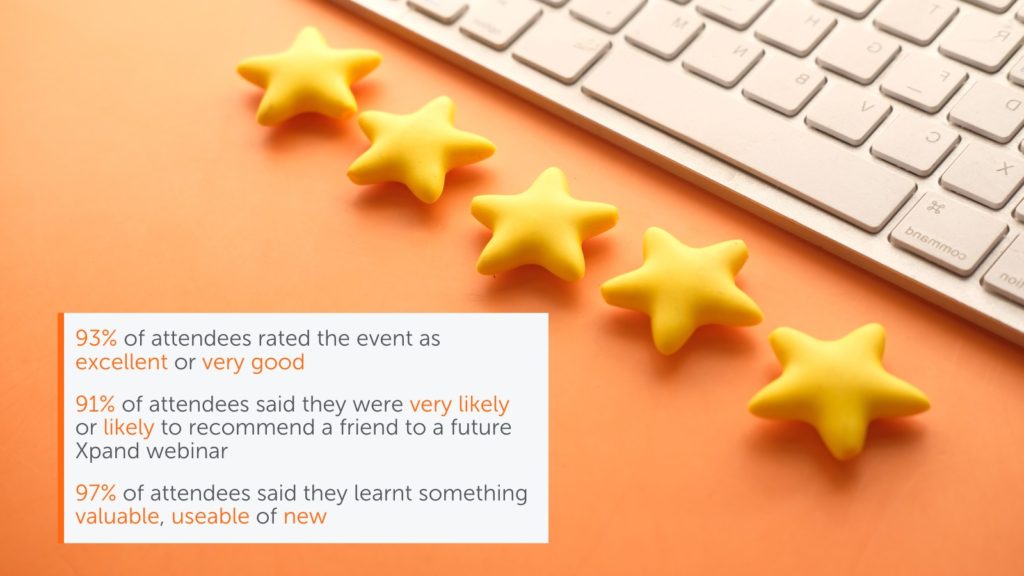
We hope that you’ve found this blog useful. If you would like any further help with working out where you need to invest your marketing budgets then, get in touch with one of our team members.
